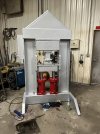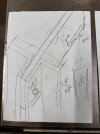- Joined
- Aug 13, 2022
- Messages
- 134
Hello Again
I am in the process of building a forging press. it will end up in the 24 25-ton range.
I have all my pump, motor cylinder stuff worked out. Thanks to all your help, a few books and my local Hydraulic shop.
The one thing I am still in the air about is do I want my ram pushing down or pushing up into a stationary upper die.
I am interested in opinions of anyone using either system and the pros and cons they see in each design.
I am more inclined to build one that the ram pushes down onto a stationary lower die but hey I'm open to advise and opinion.
Thanks Jerry
I am in the process of building a forging press. it will end up in the 24 25-ton range.
I have all my pump, motor cylinder stuff worked out. Thanks to all your help, a few books and my local Hydraulic shop.
The one thing I am still in the air about is do I want my ram pushing down or pushing up into a stationary upper die.
I am interested in opinions of anyone using either system and the pros and cons they see in each design.
I am more inclined to build one that the ram pushes down onto a stationary lower die but hey I'm open to advise and opinion.
Thanks Jerry



